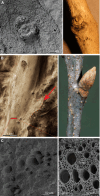Hot spring oases in the periglacial desert as the Last Glacial Maximum refugia for temperate trees in Central Europe
- PMID: 38820152
- PMCID: PMC11141633
- DOI: 10.1126/sciadv.ado6611
Hot spring oases in the periglacial desert as the Last Glacial Maximum refugia for temperate trees in Central Europe
Abstract
Northern glacial refugia are a hotly debated concept. The idea that many temperate organisms survived the Last Glacial Maximum (LGM; ~26.5 to 19 thousand years) in several sites across central and northern Europe stems from phylogeographic analyses, yet direct fossil evidence has thus far been missing. Here, we present the first unequivocal proof that thermophilous trees such as oak (Quercus), linden (Tilia), and common ash (Fraxinus excelsior) survived the LGM in Central Europe. The persistence of the refugium was promoted by a steady influx of hydrothermal waters that locally maintained a humid and warm microclimate. We reconstructed the geological and palaeohydrological factors responsible for the emergence of hot springs during the LGM and argue that refugia of this type, allowing the long-term survival and rapid post-LGM dispersal of temperate elements, were not exceptional in the European periglacial zone.
Figures








Similar articles
-
Migration patterns of subgenus Alnus in Europe since the last glacial maximum: a systematic review.PLoS One. 2014 Feb 21;9(2):e88709. doi: 10.1371/journal.pone.0088709. eCollection 2014. PLoS One. 2014. PMID: 24586374 Free PMC article.
-
Pyrenees as the southernmost European refugium of glacial relict land snails.Sci Rep. 2025 Jul 2;15(1):23076. doi: 10.1038/s41598-025-07531-3. Sci Rep. 2025. PMID: 40595249 Free PMC article.
-
Multiple glacial refugia for cool-temperate deciduous trees in northern East Asia: the Mongolian oak as a case study.Mol Ecol. 2015 Nov;24(22):5676-91. doi: 10.1111/mec.13408. Epub 2015 Oct 30. Mol Ecol. 2015. PMID: 26439083
-
Phylogeography and Population Demography of Parrotia subaequalis, a Hamamelidaceous Tertiary Relict 'Living Fossil' Tree Endemic to East Asia Refugia: Implications from Molecular Data and Ecological Niche Modeling.Plants (Basel). 2025 Jun 7;14(12):1754. doi: 10.3390/plants14121754. Plants (Basel). 2025. PMID: 40573742 Free PMC article.
-
Drugs for preventing postoperative nausea and vomiting in adults after general anaesthesia: a network meta-analysis.Cochrane Database Syst Rev. 2020 Oct 19;10(10):CD012859. doi: 10.1002/14651858.CD012859.pub2. Cochrane Database Syst Rev. 2020. PMID: 33075160 Free PMC article.
References
-
- Frenzel B., The Pleistocene vegetation of northern Eurasia. Science 161, 637–649 (1968). - PubMed
-
- Bennett K. D., Tzedakis P. C., Willis K. J., Quaternary refugia of North European trees. J. Biogeogr. 18, 103–115 (1991).
-
- Hewitt G. H., The genetic legacy of the Quaternary ice ages. Nature 405, 907–913 (2000). - PubMed
-
- Petit R. J., Aguinagalde I., de Beaulieu J.-L., Bittkau C., Brewer S., Cheddadi R., Ennos R., Fineschi S., Grivet D., Lascoux M., Mohanty A., Müller-Starck G., Demesure-Musch B., Palmé A., Martín J. P., Rendell S., Vendramin G. G., Glacial refugia: Hotspots but not melting pots of genetic diversity. Science 300, 1563–1565 (2003). - PubMed
MeSH terms
LinkOut - more resources
Full Text Sources
Research Materials
Miscellaneous

